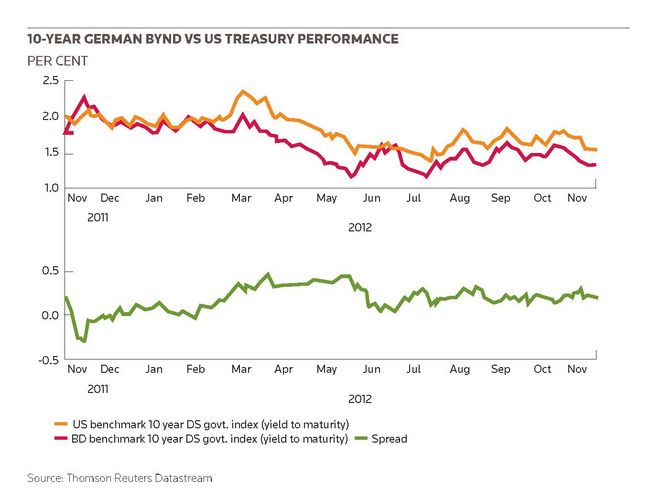To view the digital version, please click here.
Keith Mullin, IFR: As we’ve got bonds and loans people from the same bank here, I’m curious to pursue with Marc and Matthias, and Reinhard and Karin how you guys work together. You’ve all been very complimentary about each other, but I’m still told you still compete with each other for business.
Karin Arglebe, Commerzbank: I think that the change has been when you go out to clients, you don’t pitch a product, you pitch a concept. And that means doing a refinancing of the total debt side of a client. You have to have colleagues from each side, bond, loans and Schuldscheine. In the end you have a concept for this client that involves different products. We are definitely not competitors.
Reinhard Haas, Commerzbank: No, silo thinking in the current environment would be bad for any bank. This is why you have a team approach at most of the larger institutions, which offer the whole range of products and allow time to discuss what the best solution is with clients. On many occasions this will involve more than just one debt product.
Matthias Gaab, Deutsche Bank: We carry out reviews of the lending relationship and of the overall relationship. Given pending Basel III and liquidity costs etc, this may be a discussion in the first instance about the size of your lending, about the cost of it, but it will also focus on what the overall relationship is providing and generating as revenues.
And because lending is in a sense a relatively scarce resource, these days that naturally results in a joint approach where you need to figure out as a client-service team what makes sense, what the client’s needs are and how you can provide that. And if the result is that more lending is required in order to facilitate or enable the client to do certain things, then that will certainly happen. But on the other hand that’s no longer going to be a situation where one guy is taking a decision, going to the client and telling colleagues after the fact.
Marc Mueller, Deutsche Bank: Let me mirror what Matthias just said. In terms of resources, loan resources towards clients, Matthias and I are working to garner more capacity for clients if possible. In that, we’re working in the same direction. On client situations, there are two principal scenarios. One is the core syndicated loan line, which is something the capital markets can rarely deliver because it’s unfunded and it’s difficult to duplicate in the market so there’s no adequate instrument provided by the capital markets. The second is acquisition scenarios which you bridge into via the loan market but which will then be taken out in the capital market. It’s much more working together than pitching in parallel.
Johannes Heinloth, BayernLB: You heavily depend on each other, right? The bond side won’t get a mandate unless the loans side provides some balance sheet but we won’t make money on the relationship basis without you guys winning a bond mandate; it’s as simple as that.
Reinhard Haas, Commerzbank: Where your corporate clients are facing difficult situations, as a core bank you might need to help your client restructure maybe or help the client back on the road. But when the longer-term funding question is asked again and the client is in a better shape, they migrate to the bond market which is a healthy development. We saw a lot of this in 2010 to 2011.
Matthias Gaab, Deutsche Bank: In the current overall uncertain environment, it’s also, from a client’s perspective, much more important to look at their overall financing needs from a much more holistic perspective rather than on a product-by-product basis.
Claudia Hopstein, HSBC: And if you think further ahead, these developments are going hand in hand: we’re choosing what we think our client base should be, but on the other hand clients are looking more closely at their banking group as well. In this club-style view, they will pick the banks who can really deliver the banking services they require. Clients know at that point that they need to give return for the lending. It helps them put their banking groups together in a way that really serves their requirements.
For example, the small savings banks that might have been in the banking group before have been deselected. They might end up in the Schuldscheine because they want to be kept as investors in that context. But maybe they can’t deliver the full service the corporate requires. So the client is still keen on having them as a lender but you can’t fulfil everything at the same time so they split it, maybe keeping their core relationship banking group for core lending, and then bring in other banks for additional placement products.
For example, small savings banks that might have been in the banking group before have been deselected. They might end up in the Schuldscheine because they want to be kept as investors in that context. But maybe they can’t deliver the full service the corporate requires. So the client is still keen on having them as a lender but you can’t fulfil everything at the same time so they split it, maybe keeping their core relationship banking group for core lending, and then bring in other banks for additional placement products.
Reinhard Haas, Commerzbank: I should add that this shouldn’t give you the impression that Germany is a closed shop for foreign institutions. That’s not the case because the core banking concept, especially in view of the nature of the German economy being very export driven, includes core players from other markets be they from the Americas or from Asia. We also see foreign institutions as part of the overall equation.
Everybody talks about foreign banks walking away from the German market during the financial crisis. That has certainly been a fact for smaller institutions, but I think for the more globally active institutions, that is not true at all. And by the way, this is crucial for the German market, which needs their contribution in order to work correctly.
Christian Reusch, Unicredit: In the Schuldschein market you selectively see foreign branches of banks joining the club because they think this could be a good point of entry into the client to develop business where they could add value. This is certainly also playing a role.
Keith Mullin, IFR: On that issue of foreign banks pulling away, a lot of them have been forced into selling assets as part of deleveraging. Have you seen foreign banks offloading some of their German corporate lending portfolios? And who’s picking up the assets?
Reinhard Haas, Commerzbank: It’s not really a current issue; it was a problem in the aftermath of the financial crisis when Southern European banks especially had liquidity costs which were just out-pacing what any loan would pay. In these cases we’ve seen an offloading of these assets at a discount. Most of that went to local investors, not only in Germany but in the neighbouring countries as well who picked them up, and for whom it was a good play.
Johannes Hack, DZ Bank: There have been refis in between and sizes have reduced in some cases and the slack’s been taken up by the bond market. So a client who used to have a billion-plus syn-loan would say: ’well I’ll put €400m into a bond and reduce my general corporate purpose line by €300m’. That’s €300m gone overall but €700m gone from the syn-loan market.
Marc Mueller, Deutsche Bank: The over-riding theme is that German corporates don’t really have a funding issue. If there’s a capacity reduction on the loans side because loan volumes are reduced, it’s easily being absorbed by other pockets, be it real money accounts in Schuldschein format or the bond market. We’ve been seeing volumes in each of those capital market instruments on the rise. Demand is very robust and the costs for each of those pockets have been decreasing throughout the year. There’s no limitation at the moment; overall the German corporate asset class even with some reduction in bank demand on some names is being absorbed very easily.
Johannes Heinloth, BayernLB: Corporates have adapted their stance towards financing in the aftermath of the financial crisis. They’re a little bit more balanced, using capital markets, looking a little bit more properly at what they can do. From that perspective, they’ve learned their lessons in terms of not building only on one source of funding, needing to diversify, and managing a bit more proactively. That has been incorporated and it’s why from a numbers perspective, lower volumes are not necessarily crucial.
Claudia Hopstein, HSBC: This is true for the bond market, too. In most cases, particularly for the more frequent issuers, they don’t want to rely on the euro market only. They’re also looking for other currencies; they’re going into local currency markets, they’re tapping the different pockets available to them as long as they can achieve reasonable pricing. Maybe in some cases they have a natural funding requirement in a specific region anyway, so they go for Dim Sum in China or they go for Scandinavian currencies or Canadian dollars.
They’re using the sources available around the globe. Maybe that’s not possible for the smaller-size companies but at least the big companies are doing that and it’s an ongoing trend. This is something we will see even more going forward: local markets that can be tapped on a more permanent basis.
Reinhard Haas, Commerzbank: It’s interesting you mention the Chinese market. It’s a new phenomenon and not really important from a volume perspective. But the Chinese capital market will evolve strongly over time. Clients tell us they’re interested in how this local market works and want to understand the local jurisdiction. We need to anticipate future growth and understand the importance that these markets, especially export markets, will have for German corporates.
Keith Mullin, IFR: I want to focus now on your expectations for next year. What are the expectations for M&A involving German companies? CEOs see the theoretical benefits and value of buying when asset prices are low, but of course this is a confidence game. Do you foresee a pick-up in event-driven financing over the course of the next year? And if you as a group think there’ll be a pick up in M&A what will be the optimal financing mix?
Reinhard Haas, Commerzbank: We have all been waiting for this M&A wave for years. We like to finance these situations, of course, but there is a pace at which corporates invest and acquire other companies. Obviously the financial crisis hasn’t helped that process and actually slowed it down to the point where it’s almost ground to a halt.
We’ve seen activity pick up slightly but everyone hoped that there would be more than there actually has been. You have to understand the mindset of the German entrepreneur. They’re probably a little bit more prudent than their North American peers, needing more mid-term visibility. The eurozone crisis hasn’t helped that a great deal, so there’s been some reluctance.
That said, the German economy has been doing fairly well over the last three years and there is a large amount of cash on corporate balance sheets. But there’s still prudence about putting that into investments when they don’t have this medium-term visibility. What would need to happen for 2013 to really see activity pick up is the European Union tackling the peripheral debt issue a whole lot better than they have in the past.
I think as soon as we see that materialise, you will definitely see a pick up in activity, because you have to understand that Germany is a high-cost market but it’s also a high-tech market so it is a matter of survival for German corporates to invest and to also acquire certain business models. M&A is the way they do R&D, certainly in the case of pharmaceuticals. But you have to have the environment and the confidence that comes with it to make it materialise.
Keith Mullin, IFR: So it’s contingent on the eurozone crisis being resolved. That’s quite a stretch.
Johannes Heinloth, BayernLB: I would certainly agree with Reinhard. We have quite a number of examples where corporates spent quite a lot of money around 2007 where in hindsight they wouldn’t have done the same thing. There’s a high degree of caution out there. Companies are still trying to trim their balance sheets but have healthy cash piles. And financing costs are attractive, of course.
So you have quite a few arguments as to why it might pick up next year. But on the other hand I think everyone is concerned not to over-pay, and secondly not be caught by another dip and face a similar fate to that which others were faced with a couple of years ago. Most of those companies have survived but they’re paying heavily on huge debt piles now.
Karin Arglebe, Commerzbank: Companies have a lot of visibility as to potential targets, so they know they could acquire different parts of companies or companies outright. But I agree they are cautious. That’s the main point. But one thing’s for sure: no-one has any problem with saying if I have a target the financing will be not a problem.
Reinhard Haas, Commerzbank: I think there is a second aspect to that because only a part of M&A activity comes from strategic investors. On the private equity side with regard to leveraged buyouts, we’ve seen a different situation in that there was a reluctance to underwrite highly leveraged financings for M&A purposes even though they’re only a small part of the LBO market (they make up about 30% of the overall volume of leveraged financings which have an M&A background).
As a result, PEs had to turn to the US market because it was much more liquid. Some of the more interesting transactions with a European background have been financed in the US because Europe has not yet succeeded in rebuilding the CLO market. In the US, they’ve seen around US$30bn in new issuance this year and that’s expected to be US$60bn next year. That trend will continue. It’s one of the reasons we don’t see as much M&A-driven financing in Europe.
Keith Mullin, IFR: In terms of financing M&A, will we see the classic bridge to bond combination or will we see more straight bond financing of acquisitions? How far can the bond market go in financing M&A in terms of size?
Marc Mueller, Deutsche Bank: The bond market will have decent sizes available for corporates. I think the structure of financings will be important for the larger transactions being bridged in the loan market and then taken out in the various bond segments, but double-digit billion taken out into the bond market for the right name shouldn’t be a constraint.
Matthias Gaab, Deutsche Bank: What we are seeing currently is that the bond market is growing by a very significant pace in a way that expands the opportunity to finance acquisitions. This year and 2009 are the two years where the bond market in terms of size in Europe has been bigger than the loan market.
I think it very unlikely that 2013 will be any different. I would agree that M&A is a confidence game but no transactions will fail to get done because of the lack of financing. But for various reasons, be it underlying regulatory reasons or the legal framework in the country where the acquisition takes place, I think it’s extremely difficult to envisage a transaction without a bridge loan to kick-start the process.
Certainly the longer the tenor of the financing, given current refinancing costs as we’ve discussed, it’s certainly difficult to keep this on the books so it’s much more advantageous for clients to refinance via the various instruments in the bond market. The reason why loan volumes are so low is not because banks are declining lending applications; it’s too little demand.
Marc Mueller, Deutsche Bank: Let me add one thing. The confidence point is the key trigger point corporates will be looking for. This is not dependent on full resolution of the eurozone crisis. This isn’t what’s needed. I think confidence is more geared to the decline in growth rates in China, Asia and the US. This is at the centre of the confidence aspect, not a quick or a full resolution of the eurozone crisis.


